Navigation: Be Consistent
| Consistency is a fundamental concept in navigation. Keeping a consistent navigational structure helps people visualize their current location and options, and minimizes guesswork. Navigational elements act as stepping-stones to help people traverse from one area to the next. Changing navigation is like removing stepping-stones while users are still in midair; when they land, it's not where they expected. Navigation that was on the left on the previous page may now be in the middle; the categories have changed. The back button doesn't work and there's no easy way to return to the previous pages. When navigation changes drastically from one page to the next, people must shift their attention from using the site to figuring out how to use it. Web sites with unreliable navigation make users uncertain and hesitant. Large Web sites comprised of subsites or affiliated sites are notorious for committing this crime. Each subsite is usually created by a different group and has its own organization and look-and-feel. When the subsites are linked together haphazardly, user experience is atrocious. People must often request the same thing multiple times because each subsite acts independently. Corporate Web sites, for example, feel disjointed when investor relations, press relations, and product sections have their own navigational schemes and look completely different. Good navigation is predictable and makes people feel comfortable exploring the site. It doesn't need to be studied or memorized because it reflects their impression of how information should be represented in Web space. It has sense and order, and there's little or no ambiguity about where items are. Users can move forward, backtrack, explore, and feel confident that they will not lose their way.
When navigation changes drastically from one page to the next, users must shift their attention from using the site to figuring out how to use it. Web sites with unreliable navigation make users uncertain and hesitant. The simple global navigation area at the top of the Pixar site stays visible and consistent throughout the site. Whether people are on Feature Films or About Us, they know where to look for various navigational options. Our users felt that they could confidently explore the site and easily return to an area at any point: "It just states everything on top. You don't have to look around. It was set up and laid out very well. Your eyes don't have to wander all over the screen." "Everything you click is connected to each other. It seems like an easy Web site to use." 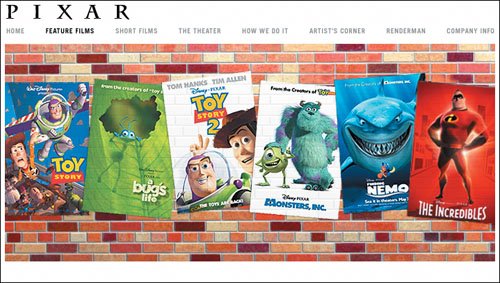 www.pixar.com 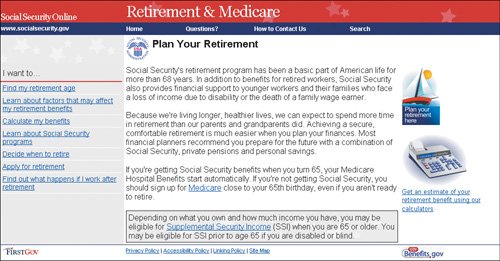 (Facing page) The overlapping content areas and inconsistent navigational options on the U.S. Social Security Web site invite errors. Selecting different but similar sounding paths yields different results. For example, finding your retirement age is easy if you select Plan Your Retirement from the homepage. However, if you opt for a different route and enter the Retirement Planner, it's more difficult to find your retirement age. The "Find my retirement age" link is prominent in the first example but not available in the second, even though both appear to be retirement planners. Compare the two screens and notice the overlapping choices between them. Such unstructured IA causes people to forget what they clicked on and what their remaining choices are, leading to comments like these: "I would think the retirement age would be easy to find, but I didn't locate it. It makes me feel stupid." "It could be more user-friendly. It needs to think like a new user."  www.ssa.gov When visitors to this site click Learn About Factors that Affect Your Retirement Benefits, the choices on the previous screen disappear and are replaced by ones that are different but somewhat related. This caused confusion among our test users. For example, it was not clear to them whether Calculate My Benefits on the previous screen is the same as Benefit Calculators. The burden is placed on users to sift through the various links and determine which are the same and which have new information. 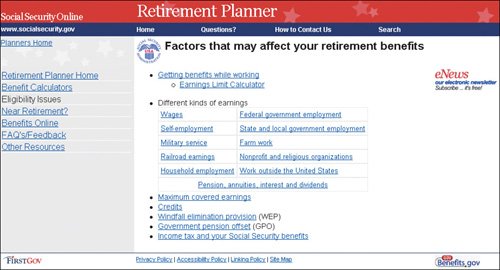 www.ssa.gov The topics under the main categories on this site expand and contract depending on which category the user selects. Each of the three panels has different topics and navigational styles. The extreme changes in navigation disoriented our users: "I'm getting myself lost. I don't know where I was now." "It has three different bars; it would be easier if it were on one homepage, rather than clicking on three places to get more information." "This is a frustrating because you can't find what you want." "I don't even remember: Did I click on fragrance? Where am I?" "It wasn't obvious where things are. You had to search and hunt more than on other sites."  www.bathandbodyworks.com (Facing page) The inconsistent navigational scheme on Nestlé's site made it difficult for our users to find their way. The global navigation changes for different sections. For example, the main navigation on the All About Nestlé page appears on top and on the side. The main navigational elements on the Nutrition page, however, are only on top, but in two levels. Here's what users said about this site: "It's not something that I will go back to because it was difficult and awkward to navigate. I like a different style of Web siteI like a side bar where you can see things. Here you have a couple top bars and other things going on. I'm all over the place." 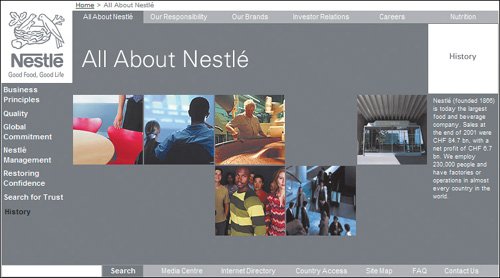 "I'm not finding what I'm looking for on this site. If I were going to look for a snack food, I would leave because I'm not seeing it." "I ended up wasting a lot of time trying to find what I need." "There is so much information. And trying to complete the tasks took a little longer than I would have thought. It got confusing trying to find a few simple things." 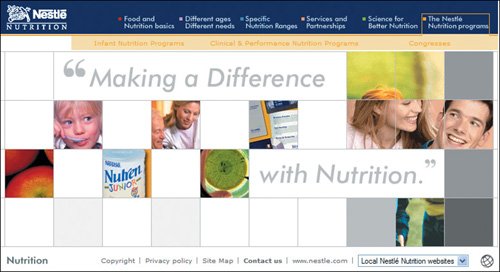 www.nestle.com |
EAN: 2147483647
Pages: 107